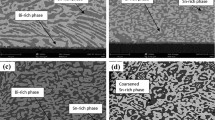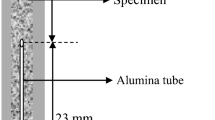Abstract
Due to the inherent environmental and health toxicities associated with lead, the use of environmental friendly lead-free solder materials has become an unavoidable trend in the electronic packaging industry. Sn-58Bi alloy is gaining attention for its good material properties such as low melting point, reliability and high tensile strength. The presence of the bismuth-rich phase increases the brittleness of Sn-58Bi alloy. The purpose of this study is to suppress the brittleness of Sn-58Bi alloy by the addition of different wt% (0, 10, 20, 30) of Sn powder. The powder metallurgy method was used to prepare the samples. Scanning electron microscopy and energy-dispersive X-ray analysis were done to study the structural properties and a tensile test was done by a universal tensile machine to study the mechanical properties. The results reveal that the Sn particles partially dissolved in the Sn-58Bi solder matrix. The dissolution of Sn particles significantly improved the mechanical strength by 30%, suppressed the brittleness and improved the strain value by 1.3 times.






Similar content being viewed by others
Data availability
The current study is based on experimental data. In manuscript, the experimental data was correlated and discussed with existing studies done by other researchers (given in the references). The experimental data of current study is unpublished and will be provided for the evidence and for the review.
References
S.K. Kang, A.K. Sarkhel, Lead (Pb)-free solders for electronic packaging. J. Electron. Mater. 23(8), 701–707 (1994)
C. Yang et al., Recycling tin from electronic waste: a problem that needs more attention. ACS Sustain. Chem. Eng. 5(11), 9586–9598 (2017)
E. Ringgaard, T. Wurlitzer, Lead-free piezoceramics based on alkali niobates. J. Eur. Ceram. Soc. 25(12), 2701–2706 (2005)
L.-H. Su et al., Interfacial reactions in molten Sn/Cu and molten In/Cu couples. Metall. Mater. Trans. B. 28(5), 927–934 (1997)
M. Goosey, An overview of the current status of lead-free assembly and related issues. Circ. world (2003). https://doi.org/10.1108/03056120310478541
Miric, A.Z. and A. Grusd. 1998 Lead‐free alloys. Soldering & Surface Mount Technology.
L. Xu et al., Design and performance of Ag nanoparticle-modified graphene/SnAgCu lead-free solders. Mater. Sci. Eng., A 667, 87–96 (2016)
Bradley, E. Lead-free solder assembly: impact and opportunity. in Electronic Components and Technology Conference. 2003. IEEE; 1999.
Sahasrabudhe, S., et al. Low Temperature Solder-A Breakthrough Technology for Surface Mounted Devices. in 2018 IEEE 68th Electronic Components and Technology Conference (ECTC). 2018. IEEE.
Z. Mei, J. Morris, Characterization of eutectic Sn-Bi solder joints. J. Electron. Mater. 21(6), 599–607 (1992)
A.K. Gain, L. Zhang, Growth mechanism of intermetallic compound and mechanical properties of nickel (Ni) nanoparticle doped low melting temperature tin–bismuth (Sn–Bi) solder. J. Mater. Sci.: Mater. Electron. 27(1), 781–794 (2016)
Y. Liu, K. Tu, Low melting point solders based on Sn, Bi, and In elements. Mater. Today Adv. 8, 100115 (2020)
C. Yin et al., The effect of reflow process on the contact resistance and reliability of anisotropic conductive film interconnection for flip chip on flex applications. Microelectron. Reliab. 43(4), 625–633 (2003)
C. Yu et al., First-principles investigation of the structural and electronic properties of Cu6− xNixSn5 (x= 0, 1, 2) intermetallic compounds. Intermetallics 15(11), 1471–1478 (2007)
S. Nai, J. Wei, M. Gupta, Interfacial intermetallic growth and shear strength of lead-free composite solder joints. J. Alloy. Compd. 473(1–2), 100–106 (2009)
Z. Wang et al., Influences of Ag and In alloying on Sn-Bi eutectic solder and SnBi/Cu solder joints. J. Mater. Sci.: Mater. Electron. 30(20), 18524–18538 (2019)
W.-H. Chen et al., IMC growth reaction and its effects on solder joint thermal cycling reliability of 3D chip stacking packaging. Microelectron. Reliab. 53(1), 30–40 (2013)
A.C. So, Y.C. Chan, Reliability studies of surface mount solder joints-effect of Cu-Sn intermetallic compounds. IEEE Trans. Compon. Packag. Manuf. Technol. Part B: 19(3), 661–668 (1996)
H.R. Kotadia, P.D. Howes, S.H. Mannan, A review: on the development of low melting temperature Pb-free solders. Microelectron. Reliab. 54(6–7), 1253–1273 (2014)
L.S. Kamaruzzaman, Y. Goh, Effects of alloying element on mechanical properties of Sn-Bi solder alloys: a review. Solder Surf Mount Technol (2022). https://doi.org/10.1108/SSMT-06-2021-0035
P. Yao, P. Liu, J. Liu, Effects of multiple reflows on intermetallic morphology and shear strength of SnAgCu–xNi composite solder joints on electrolytic Ni/Au metallized substrate. J. Alloy. Compd. 462(1–2), 73–79 (2008)
M. Ahmed et al., Influence of Ag micro-particle additions on the microstructure, hardness and tensile properties of Sn–9Zn binary eutectic solder alloy. Microelectron. Reliab. 50(8), 1134–1141 (2010)
S. Chang et al., Effect of addition of TiO2 nanoparticles on the microstructure, microhardness and interfacial reactions of Sn3 5AgXCu solder. Mater Des. 32(10), 4720–4727 (2011)
M.N. Bashir et al., Reduction of electromigration damage in SAC305 solder joints by adding Ni nanoparticles through flux doping. J. Mater. Sci. 50(20), 6748–6756 (2015)
M.N. Bashir et al., Effect of cobalt doping on the microstructure and tensile properties of lead free solder joint subjected to electromigration. J. Mater. Sci. Technol. 32(11), 1129–1136 (2016)
M.N. Bashir, A. Haseeb, Improving mechanical and electrical properties of Cu/SAC305/Cu solder joints under electromigration by using Ni nanoparticles doped flux. J. Mater. Sci.: Mater. Electron. 29(4), 3182–3188 (2018)
M.N. Bashir, A. Haseeb, Grain size stability of interfacial intermetallic compound in Ni and Co nanoparticle-doped SAC305 solder joints under electromigration. J. Mater. Sci.: Mater. Electron. (2022). https://doi.org/10.1007/s10854-022-08352-0p.1-9
S. Nai, J. Wei, M. Gupta, Improving the performance of lead-free solder reinforced with multi-walled carbon nanotubes. Mater. Sci. Eng., A 423(1–2), 166–169 (2006)
G. Xu et al., Retarding the electromigration effects to the eutectic SnBi solder joints by micro-sized Ni-particles reinforcement approach. J. Alloy. Compd. 509(3), 878–884 (2011)
Li, J.-G., et al. Effects of Sb addition on the microstructure and mechanical performance of Sn58Bi based alloys and the solder joints. in 2018 19th International Conference on Electronic Packaging Technology (ICEPT). 2018. IEEE.
J. Shen et al., Effects of minor Cu and Zn additions on the thermal, microstructure and tensile properties of Sn–Bi-based solder alloys. J. Alloy. Compd. 614, 63–70 (2014)
Y. Li, Y. Chan, Effect of silver (Ag) nanoparticle size on the microstructure and mechanical properties of Sn58Bi–Ag composite solders. J. Alloy. Compd. 645, 566–576 (2015)
S. Liu et al., Effects of Ag on the microstructure and shear strength of rapidly solidified Sn–58Bi solder. J. Mater. Sci.: Mater. Electron. 30(7), 6701–6707 (2019)
K. Suganuma, Advances in lead-free electronics soldering. Curr. Opin. Solid State Mater. Sci. 5(1), 55–64 (2001)
H. Kang, S.H. Rajendran, J.P. Jung, Low melting temperature Sn-Bi solder: Effect of alloying and nanoparticle addition on the microstructural, thermal, interfacial bonding, and mechanical characteristics. Metals 11(2), 364 (2021)
M. Abtew, G. Selvaduray, Lead-free solders in microelectronics. Mater. Sci. Eng. R. Rep. 27(5–6), 95–141 (2000)
Wang, J., et al. Mechanical properties and joint reliability improvement of Sn-Bi alloy. in 2011 IEEE 13th Electronics Packaging Technology Conference. 2011. IEEE.
C. Wu et al., Properties of lead-free solder alloys with rare earth element additions. Mater. Sci. Eng. R. Rep. 44(1), 1–44 (2004)
Lee, S.F., Y. Goh, and A. Haseeb. Effects of stacking sequence of electrodeposited Sn and Bi layers on reflowed Sn-Bi solder alloys. in 2012 35th IEEE/CPMT International Electronics Manufacturing Technology Conference (IEMT). 2012. IEEE.
C.C. Yec, H.C. Zeng, Synthesis of complex nanomaterials via Ostwald ripening. J. Mater. Chem. A 2(14), 4843–4851 (2014)
L. Yang et al., Microstructure, IMCs layer and reliability of Sn-58Bi solder joint reinforced by Mo nanoparticles during thermal cycling. Mater. Charact. 148, 280–291 (2019)
Q. Wang et al., A micro-alloyed Mg-Sn-Y alloy with high ductility at room temperature. Mater. Sci. Eng., A 735, 131–144 (2018)
Y.-H. Liao et al., A comprehensive study of electromigration in pure Sn: effects on crystallinity, microstructure, and electrical property. Acta Mater. 200, 200–210 (2020)
D. Ye et al., Microstructure and mechanical properties of Sn–xBi solder alloy. J. Mater. Sci.: Mater. Electron. 26(6), 3629–3637 (2015)
D. Soares et al., The effect of Bi addition on the electrical and microstructural properties of SAC405 soldered structure. Solder. Surf. Mount Technol. 33(1), 19–25 (2020)
X. Liu et al., Melting behavior and the correlation of Sn distribution on hardness in a nanostructured Al–Sn alloy. Mater. Sci. Eng., A 506(1–2), 1–7 (2009)
S.-C. Jin et al., Improvement in tensile strength of extruded Mg–5Bi alloy through addition of Sn and its underlying strengthening mechanisms. J. Magnes. Alloys (2021). https://doi.org/10.1016/j.jma.2021.05.009
Acknowledgements
The financial support was provided by City, University of London, United Kingdom and University of Malaya, Kuala Lumpur, Malaysia.
Funding
The authors have not disclosed any funding.
Author information
Authors and Affiliations
Contributions
All authors contributed equally.
Corresponding authors
Ethics declarations
Conflict of interests
The authors have no relevant financial interests to disclose.
Ethical approval
The authors followed the ethical standards during the experiments as well as for preparation of manuscript.
Additional information
Publisher's Note
Springer Nature remains neutral with regard to jurisdictional claims in published maps and institutional affiliations.
Rights and permissions
Springer Nature or its licensor holds exclusive rights to this article under a publishing agreement with the author(s) or other rightsholder(s); author self-archiving of the accepted manuscript version of this article is solely governed by the terms of such publishing agreement and applicable law.
About this article
Cite this article
Bashir, M.N., Saad, H.M., Rizwan, M. et al. Effects of tin particles addition on structural and mechanical properties of eutectic Sn–58Bi solder joint. J Mater Sci: Mater Electron 33, 22499–22507 (2022). https://doi.org/10.1007/s10854-022-09028-5
Received:
Accepted:
Published:
Issue Date:
DOI: https://doi.org/10.1007/s10854-022-09028-5




